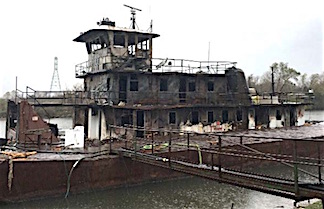The following is text of a marine accident brief from the National Transportation Safety Board (NTSB):
(WASHINGTON) — About 1340 local time on Dec. 13, 2017, the towing vessel J.W. Herron was shifting barges on Big Bayou Canot near Twelvemile Island, approximately eight miles north of Mobile, Ala., when a fire began in the lower engine room and quickly spread. After the crew of three partially secured the engines and fuel supply, heavy smoke and fire prevented them from attempting to extinguish the fire, forcing an immediate evacuation of the vessel to the barges. No pollution or injuries were reported. The estimated damage to the vessel was $1.5 million.
Probable cause
The National Transportation Safety Board determines that the probable cause of the engine room fire aboard the towing vessel J.W. Herron was leaking lube oil from a propulsion diesel engine hose or tubing fitting that was ignited off an exposed hot engine surface or slipping clutch. Contributing to the severity of the fire was the location of the emergency engine shutdowns and fuel supply shutoffs near the exterior engine room doors, which proved to be inaccessible. Also contributing to the spread of the fire was the inability to secure ventilation to the engine room.
Click here to read the report.
Report excerpt
Although the engineer stated that he did not know the cause of the fire, he suggested that it might have been a lack of oil in the engine’s gear-driven air blower or the heat of a slipping clutch. The vessel did not have an alarm alerting the crew to low air pressure to the clutch; however, the engineer checked the clutch pressure during the transit and stated that it was normal, as were the oil pressures and other machinery temperatures. He did not recall any fuel leaks from the engines under typical operation, but he had previously seen engine vibrations loosen copper tubing flare fittings, which would then weep oil. He resolved the leaking fittings by tightening them while under way. According to the engineer, a 3/8-inch copper tubing with flare fittings was supplying lube oil to the air blowers above the clutch; the operating pressure in the line was approximately 18 pounds and the engine sump held approximately 80 gallons of oil. Investigators confirmed that the oil supply line constructed of steel ran inside the valve covers down the starboard side of the engine, transitioned to copper tubing upon exiting the valve covers, and remained copper to the blowers. The fittings and tubes appeared to be intact post-fire but were not pressure-tested. In the past, the engineer had attempted to replace the copper tubing with steel per the engine manual, but he could not find the part in steel.
Above the clutch were also twin 1.5-inch stainless steel-braided rubber hoses, held in place with double hose clamps, that vented the engine crankcase to the air blowers. After the fire, these hoses were missing.

